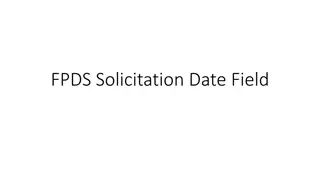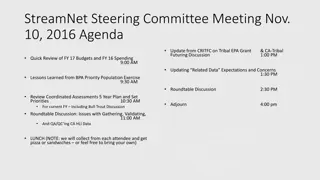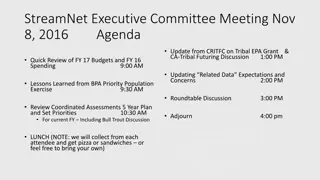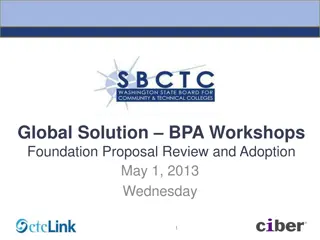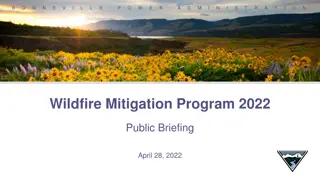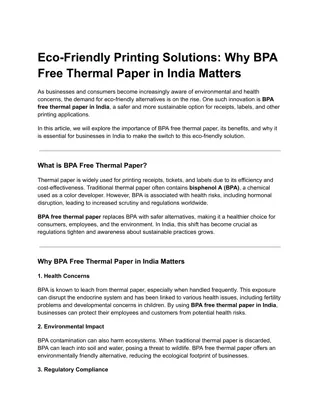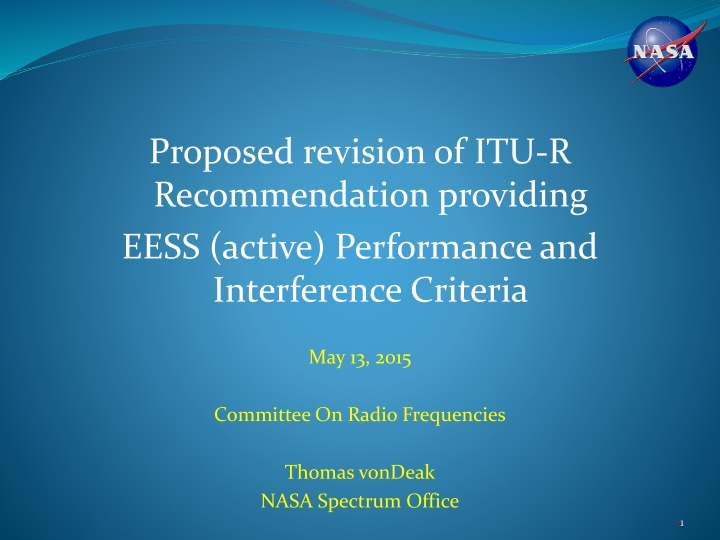
Proposed Revision of ITU-R Recommendation for EESS Active Performance Criteria
Explore the proposed revision of ITU-R Recommendation focusing on active Earth exploration satellite systems' performance and interference criteria. The document discusses protection measures, development schedules, and application guidelines for active spaceborne sensors. It outlines performance degradation metrics, data availability criteria, and the impact of interference on sensor operations.
Download Presentation

Please find below an Image/Link to download the presentation.
The content on the website is provided AS IS for your information and personal use only. It may not be sold, licensed, or shared on other websites without obtaining consent from the author. If you encounter any issues during the download, it is possible that the publisher has removed the file from their server.
You are allowed to download the files provided on this website for personal or commercial use, subject to the condition that they are used lawfully. All files are the property of their respective owners.
The content on the website is provided AS IS for your information and personal use only. It may not be sold, licensed, or shared on other websites without obtaining consent from the author.
E N D
Presentation Transcript
Proposed revision of ITU-R Recommendation providing EESS (active) Performance and Interference Criteria May 13, 2015 Committee On Radio Frequencies Thomas vonDeak NASA Spectrum Office 1
EESS (active) Protection Criteria Review of Recommendation ITU-R RS.1166-4 Performance and interference criteria for active spaceborne sensors Application of the Interference and Data availability criteria to compatibility studies Availability: Measurement area of interest versus global Considering the instantaneous peak power of the interferer Sensor susceptibility to interference 2
Development Schedule The work on the WRC-15 Agenda item 1.6 studies made us aware of improvements needed for Rec. ITU-R RS.1166-4. Actual work on revising RS.1166-4 was delayed until after WRC-15 so as to not call into question the validity of the on-going studies. To capture the issues discovered, a working document to revise Rec. ITU-R RS.1166-4 has been carried forward in the ITU-R Working Party 7C Chairman Report for the past three meetings. The work to revise Rec. ITU-R RS.1166-4 is anticipated to occur between WRC-15 and WRC-19. 3
Rec. ITU-R RS.1166-4 Performance and interference criteria for active spaceborne sensors Recommends 2 that the interference and data availability criteria given in Table 2 be applied for instruments used for active sensing of the Earth s land, oceans and atmosphere. TABLE 2 Data availability criteria (%) Interference criteria Sensor type I/N (dB) 6 3 Performance degradation Systematic Random 10% degradation of standard deviation of pixel power 4% degradation in height noise 8% degradation in measurement of normalized radar backscatter to deduce wind speeds 7% increase in minimum rainfall rate 10% degradation in minimum cloud reflectivity Synthetic aperture radar Altimeter 99 99 95 95 Scatterometer 5 99 95 Precipitation radar Cloud profile radar 10 10 N/A 99 99.8 95 NOTES: - Systematic data availability criteria isn t applicable to precipitation radar. - For bands with secondary allocation, the interference criteria are provided only to indicate performance degradation with regard to primary services. (i.e., the data availability criteria cannot be applied.) 4
Application of the Performance and interference criteria The random data availability requirement is 95%, assuming that the interference events exceeding the protection criteria are: 1. brief (i.e., most outages lasting 2 s or less) and 2. randomly dispersed over all observation time and areas. The data availability requirement is 99% for any geographical areas of interest. The impact of interference that is always present at a given geographical location (systematic) is much more serious than that of random interference, because measurements can never be obtained from those geographical areas. In shared frequency bands, data availability shall exceed 95% of all locations in the sensor service area in the case where the loss occurs randomly, and 99% of all locations in the case where the loss occurs systematically at the same locations. 5
Compatibility Analysis Static Dynamic Random Data Criteria Systematic Data Availability I/N exceedance 95% Availability 99% Availability Single Global Global Area of interest Worst case Average Average Worst case Remote Sensing System Remote Sensing System Remote Sensing System Single source interferer Global interferers Global interferers Analysis not typically done with this criteria. Exception: Precipitation Radar. 6
Geographical area of interest The geographical area of interest: As large as the entire sensor repeat cycle over the entire Earth. As small as smallest measureable area investigated. The actual measurement samples used by the investigator need to be known to the analyst in order to properly assess the potential interference impact. 7
Measurement area of interest USDA global reservoir and lake monitoring program 8
Measurement Area of interest Assumed measurements for the area of interest Blue lines within red outline are every sensor ground track within the area of interest Proposed Japanese Altimeter 9
Compatibility Analysis Input parameters Relevant compatibility study characteristics Sensor characteristics System noise, antenna pattern Detection type (e.g., peak, average power) Sample period Background Noise sampling procedure Offending Transmitter characteristics Power (Peak or Median), antenna gain and pointing, deployment characteristics Modulation scheme Media access method (e.g., TDMA) Link parameters Distance separation, shielding Evaluation Criteria Victim receiver acceptable limits of interference (Protection criteria) based on the interpretation of Rec. ITU-R RS.1166-4 Amount of degradation to victim receiver signal that can be tolerated. (Interference to Noise ratio) Percentage of time the degradation can be tolerated. 10
Peak to Average Power Ratio Median output power of the interference source is typically used in ITU-R compatibility studies. The EESS (active) altimeter detects and records the peak reflected signal. The difference between using the peak power of the interferer versus the median power can easily influence the results. 11
WHY PAPR MATTERS Altimeters detect this. Peak Power 7.4 dB ITU-R studies use This. Average Power Our understanding is that SARs, Precipitation Radars, Scatterometers, and Cloud Profile Radars detect the average power of return signals. Therefore, it is assumed that compatibility studies for those sensors can be conducted using the median power of the interferer. 12
Peak to Average Power Ratio Five common modulations. Single carrier/passband operation. 13
Other topics to be investigated Relevant EESS (active) sensor parameters for interference impact assessment Sensor parameters Preliminary list of EESS (active) sensor parameters to be considered in examining a sensor susceptibility to interference Peak vs Average power detection Number of subsamples in a sample Minimum Background noise measurement Sub sample size (ms) Pixel size (km2) measurement area of interest Sensor type Altimeter Scatterometer Precipitation Radar Synthetic Aperture Radar (SAR) Cloud Profile Radar 14
FINI 15
















